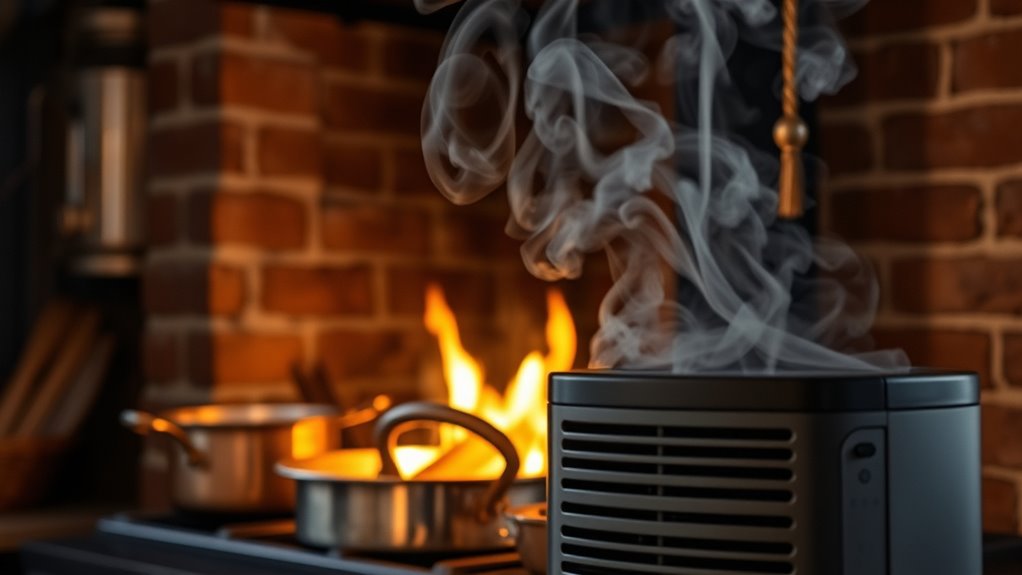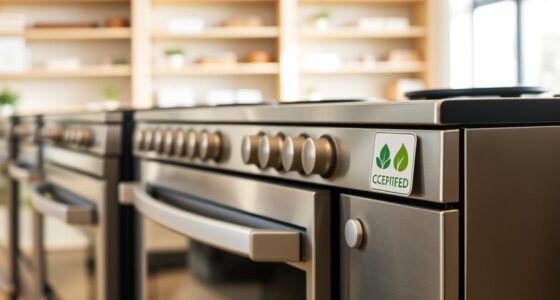Black carbon from wood stoves substantially impacts climate change and air quality. Incomplete combustion releases black carbon particles that settle on snow and ice, speeding up melting. To reduce emissions, use dry, seasoned wood, operate your stove correctly, and opt for EPA-certified models. Regular maintenance and proper fuel use ensure cleaner burning. If you want to learn more about effective mitigation strategies and their benefits, keep following for practical guidance.
Key Takeaways
- Black carbon from wood stoves accelerates snow and ice melting, contributing to climate change.
- Improving stove efficiency through regular maintenance reduces black carbon emissions.
- Using seasoned, dry wood and proper operation promotes complete combustion and minimizes pollutants.
- Upgrading to EPA-certified or advanced combustion stoves significantly decreases black carbon output.
- Avoiding overfiring and burning trash helps prevent excess smoke and black carbon release.

Wood stoves are a common source of household heating, but they also emit considerable amounts of black carbon, a potent climate forcer. As someone who relies on a wood stove, you might not realize the impact your heating choices have on the environment. Black carbon particles from incomplete combustion settle on snow and ice, accelerating melting and contributing to climate change. To address this, focusing on emissions reduction becomes vital. Improving stove efficiency is a critical step because a more efficient stove burns wood completely, producing less black carbon. When your stove operates efficiently, it not only heats your home better but also minimizes harmful emissions, helping to protect the climate.
Enhancing stove efficiency involves using well-maintained equipment, proper fuel, and correct operation techniques. Regularly cleaning your stove and chimney ensures ideal combustion, reducing black carbon output. Using seasoned, dry wood instead of green or wet logs allows for a cleaner burn, which directly cuts down on particulate emissions. Additionally, investing in modern, EPA-certified stoves can greatly improve efficiency. These stoves are designed to burn wood more completely, emitting fewer pollutants and making your heating more environmentally friendly. When you prioritize stove efficiency, you’re actively contributing to emissions reduction efforts, which benefits both your household and the planet.
Moreover, you can adopt practices that further reduce black carbon emissions. For example, avoiding the temptation to overfire your stove or burn trash, which creates excessive smoke and particles, can make a difference. Properly controlling airflow ensures complete combustion, which not only improves efficiency but also reduces black carbon emissions. If you’re considering upgrading your stove, look for models with advanced combustion technology that maximize efficiency and minimize emissions. These investments might seem small at first glance but have a cumulative effect on emissions reduction over time. Increasing awareness of climate forcers can motivate more sustainable choices in household heating.
Frequently Asked Questions
How Does Black Carbon Impact Human Health?
Black carbon harms your respiratory health by contaminating indoor air quality through wood stove emissions. Breathing in black carbon particles can cause or worsen asthma, bronchitis, and other respiratory issues. When these particles settle in your lungs, they can lead to inflammation and reduce lung function over time. To protect yourself, make certain of good ventilation and consider cleaner heating options, because maintaining healthy indoor air quality is essential for your overall well-being.
Are There Specific Regions Most Affected by Wood Stove Emissions?
Regionally, rural communities are most affected by wood stove emissions, creating clear, concentrated hotspots. You’ll notice these areas often face higher black carbon levels, which can harm health and worsen air quality. These communities rely heavily on wood for heating, making them vulnerable to pollution. If you live or work nearby, you might experience more pollution, highlighting the need for targeted mitigation efforts to reduce risks and protect residents.
What Are Cost-Effective Ways to Upgrade Existing Stoves?
You can improve stove efficiency and reduce emissions with cost-effective upgrades like installing catalytic converters, upgrading to EPA-certified stoves, or adding heat shields. Regular maintenance, such as cleaning chimneys and replacing worn parts, also boosts efficiency. These upgrades often require minimal investment but markedly cut black carbon emissions. By choosing these options, you’ll make your stove more efficient, save money on fuel, and contribute to cleaner air.
How Do Weather Conditions Influence Black Carbon Dispersion?
Weather conditions play a big role in black carbon dispersion. Wind patterns help spread emissions over a wider area, reducing local pollution but possibly affecting nearby communities. Temperature inversions trap black carbon close to the ground, leading to higher concentrations and worsening air quality. When you understand these factors, you can better predict pollution hotspots and take steps to minimize health impacts, especially during calm, clear weather with temperature inversions.
Can Alternative Fuels Significantly Reduce Black Carbon Emissions?
Using alternative fuels can substantially reduce black carbon emissions, helping you lower your environmental impact. These fuels burn more cleanly, producing fewer particulates and pollutants. By switching to options like biofuels or cleaner energy sources, you actively participate in emission reduction efforts. This not only benefits air quality but also supports climate change mitigation. So, choosing alternative fuels is an effective step toward a healthier environment and a more sustainable future.
Conclusion
To wrap things up, addressing black carbon emissions from wood stoves isn’t just about ticking boxes; it’s about taking responsibility for a cleaner future. By adopting cleaner burning technologies and proper maintenance, you can markedly cut emissions and make a real difference. Remember, a stitch in time saves nine—early action prevents bigger problems down the line. So, don’t wait for problems to escalate; start making smarter choices today for a healthier environment tomorrow.











